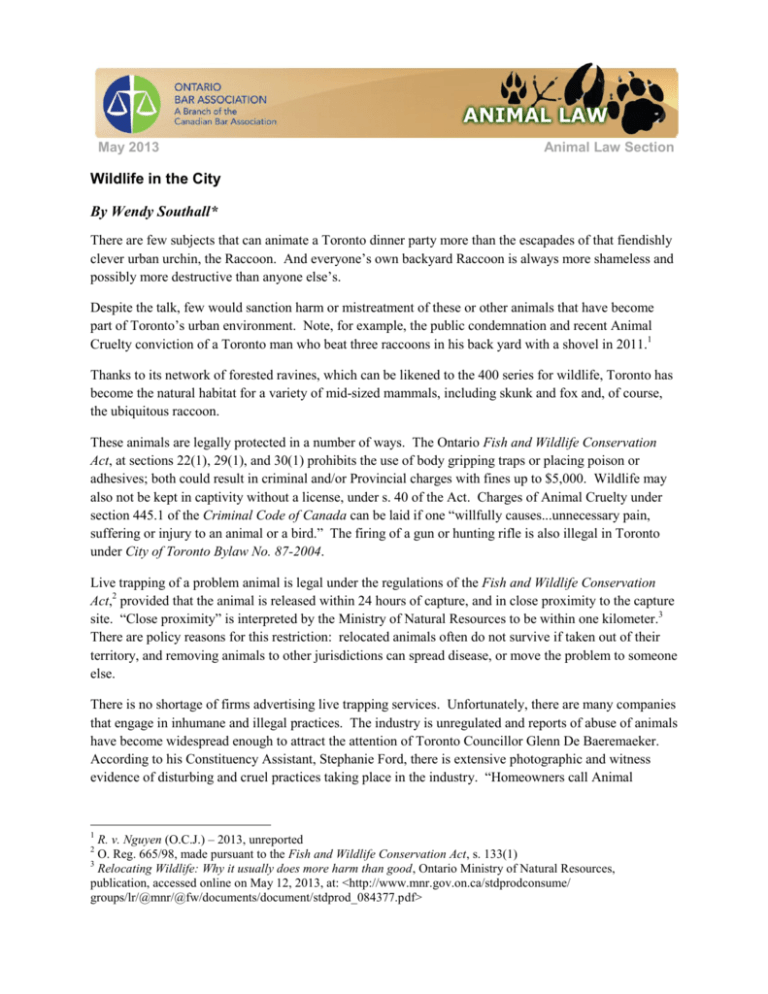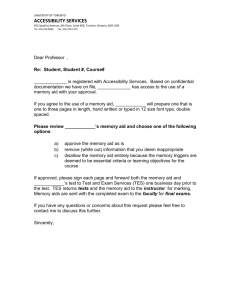A Primer on Municipalities and Constitutional Law
advertisement

May 2013 Animal Law Section Wildlife in the City By Wendy Southall* There are few subjects that can animate a Toronto dinner party more than the escapades of that fiendishly clever urban urchin, the Raccoon. And everyone’s own backyard Raccoon is always more shameless and possibly more destructive than anyone else’s. Despite the talk, few would sanction harm or mistreatment of these or other animals that have become part of Toronto’s urban environment. Note, for example, the public condemnation and recent Animal Cruelty conviction of a Toronto man who beat three raccoons in his back yard with a shovel in 2011.1 Thanks to its network of forested ravines, which can be likened to the 400 series for wildlife, Toronto has become the natural habitat for a variety of mid-sized mammals, including skunk and fox and, of course, the ubiquitous raccoon. These animals are legally protected in a number of ways. The Ontario Fish and Wildlife Conservation Act, at sections 22(1), 29(1), and 30(1) prohibits the use of body gripping traps or placing poison or adhesives; both could result in criminal and/or Provincial charges with fines up to $5,000. Wildlife may also not be kept in captivity without a license, under s. 40 of the Act. Charges of Animal Cruelty under section 445.1 of the Criminal Code of Canada can be laid if one “willfully causes...unnecessary pain, suffering or injury to an animal or a bird.” The firing of a gun or hunting rifle is also illegal in Toronto under City of Toronto Bylaw No. 87-2004. Live trapping of a problem animal is legal under the regulations of the Fish and Wildlife Conservation Act,2 provided that the animal is released within 24 hours of capture, and in close proximity to the capture site. “Close proximity” is interpreted by the Ministry of Natural Resources to be within one kilometer.3 There are policy reasons for this restriction: relocated animals often do not survive if taken out of their territory, and removing animals to other jurisdictions can spread disease, or move the problem to someone else. There is no shortage of firms advertising live trapping services. Unfortunately, there are many companies that engage in inhumane and illegal practices. The industry is unregulated and reports of abuse of animals have become widespread enough to attract the attention of Toronto Councillor Glenn De Baeremaeker. According to his Constituency Assistant, Stephanie Ford, there is extensive photographic and witness evidence of disturbing and cruel practices taking place in the industry. “Homeowners call Animal 1 R. v. Nguyen (O.C.J.) – 2013, unreported O. Reg. 665/98, made pursuant to the Fish and Wildlife Conservation Act, s. 133(1) 3 Relocating Wildlife: Why it usually does more harm than good, Ontario Ministry of Natural Resources, publication, accessed online on May 12, 2013, at: <http://www.mnr.gov.on.ca/stdprodconsume/ groups/lr/@mnr/@fw/documents/document/stdprod_084377.pdf> 2 2 Service, frantic. Animals have been caught in cages on their property and the companies don’t come back and don’t respond. The animal is suffering and the homeowner has no idea what to do.” Councillor De Baeremaeker, as well as representatives from the City of Markham, are working with the industry to set standards and a mandatory licensing requirement for trapping companies operating in Toronto or Markham. In the meantime, it is up to the individual property owner to use best efforts to ensure that the law is being followed by any company offering to trap and relocate an animal on his or her property. There are many reputable websites, including the City of Toronto’s own site, which provide detailed tips on preventing and managing urban wildlife to eliminate conflicts. Toronto’s wildlife is here to stay – providing fodder for dinner party stories well into the future. *Wendy Southall practiced Family Law at the firm of Bresver Grossman Scheininger and Chapman for many years, and is currently on sabbatical







